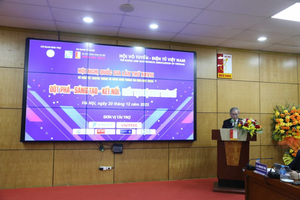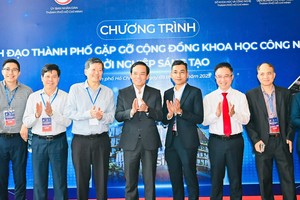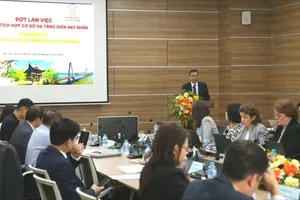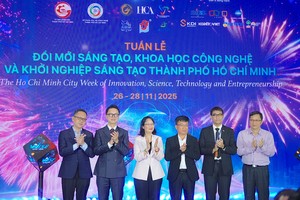Demand for chips related to the rapidly growing use of AI will contribute significantly to the world semiconductor chip market’s overall growth; leading to a thirst for human resources in the field of IC design industry whereas leading countries in semiconductor microchips are facing a serious shortage of human resources, so this is a great opportunity for Vietnam.
Vietnam welcomes the opportunity
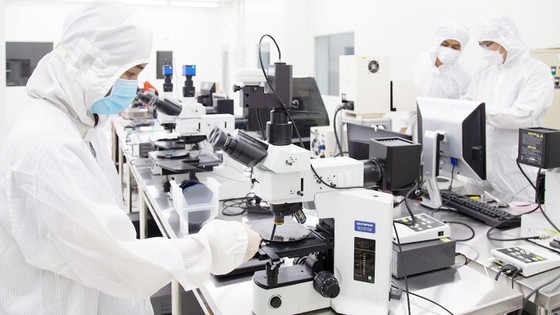 |
Staff in SHTP are making microchips (Photo: SGGP) |
Ho Chi Minh City National University established the IC Design and Training Center (ICDREC) in 2005 and the Nanotechnology Laboratory (LNT), now the Institute of Nanotechnology (INT). In 2010, semiconductor microchips were added to the list of high technology and high technology products prioritized for investment and development according to the Prime Minister’s Decision No. 49/2010/QD-TTg.
In 2012, microchips were identified as national products according to the Prime Minister’s Decision No. 439/QD-TTg issued on April 16, 2012. In 2012, the People's Committee of Ho Chi Minh City also issued a Program to develop the IC industry from 2013 to 2020 with a vision to 2030. The above moves affirm the determination to develop the IC industry in Vietnam in general and of HCMC in general.
Director of the city Department of Science and Technology Nguyen Viet Dung said that investment in microchips requires a long-term strategy at the national level. The microchip industry in the Southeast Asian country is hard to form soon of its poor investment in the past time. However, the policies and programs for the development of microchips in the country in recent years have achieved some results. These policies will pave the way for the development of the microchip industry and accordingly, more people have been trained to work in the industry.
According to data released by the National Science and Technology Information Portal, Vietnam had 1,072 international publications related to the semiconductor industry by the end of 2022 including 635 international publications related to microchips. Notably, about 5,000 Vietnamese engineers are currently working in the field of IC design mostly in Ho Chi Minh City with 85 percent, Hanoi with 8 percent and Da Nang with 7 percent. Despite that, the workforce in the industry is still very modest, especially for Vietnam's microchip industry development strategy.
Since 2019, the Korean Government has had a strategy to support the development of the IC industry. In the next 10 years, this country needs 10,000 senior engineers but the education and training can only provide 5,000 engineers. Worse, it needs 127,000 engineers in the next 10 years but 50,000 engineers will be trained.
Professor Lee Hyuk-Jae, Head of the Department of Electrical and Computer Engineering at Seoul National University gave another example. Samsung is currently the leading corporation in Korea in microchip technology, but currently, they cannot compete with their rivals as they only have 10,000 engineers, while their competitors have up to 30,000. -40,000 engineers. Human resources are extremely important in the microchip industry and Vietnam needs to anticipate this.
Training quality human resources
Associate Professor Nguyen Anh Thi, Head of the Management Board of the Ho Chi Minh City High-Tech Park (SHTP), said that SHTP puts a lot of effort into building the microchip industry and first of all, it has been building human resources. By 2030, the SHTP Training Center aims to train 50,000 semiconductor circuit design engineers in Vietnam.
To realize this goal, the SHTP Management Board cooperated with Synopsys Company to establish the SHTP Circuit Design Training Center - SHTP Chip Design Center (SCDC) in August 2022.
In March this year, the SHTP Management Board and the Sun Electronics Group put into operation the International Electronics Training Center (IETC - two important centers directly contributing to improving the quality of human resources in the microchip industry, namely circuit design and application.
On August 30, Synopsys Vietnam Company and SHTP Training Center (SHTP Training Center) closed the circuit design training course (ITP) in 2023. The ITP 2023 training course has selected the 30 best students among more than 500 engineers who are graduates and final-year university students. Students can learn and practice on all IC design software according to equivalent global training programs in the US, and India and access to libraries, Synopsys’ practical industrial and professional microchips design.
Along with IC design, integrated circuit packaging - the final stage of semiconductor device fabrication - is also Vietnam's strength with the presence of strategic investor Intel at SHTP. The ecosystem of businesses within the supply chain of the Intel packaging factory is also gradually formed and strengthened along with the development of the Intel project.
The presence of Korean IC design companies, SNST &Finger Vina Company at SHTP and CoAsia in Hanoi, and recently the IC packaging and testing factory projects of Amkor in the Northern Province of Bac Ninh and Samsung in Northern Province of Thai Nguyen has shown that the scale of Vietnam's electronics industry is large enough to lead to the development of the semiconductor chip industry. Therefore, demand for microchip human resources is forecast to continue to be up in the near future.

